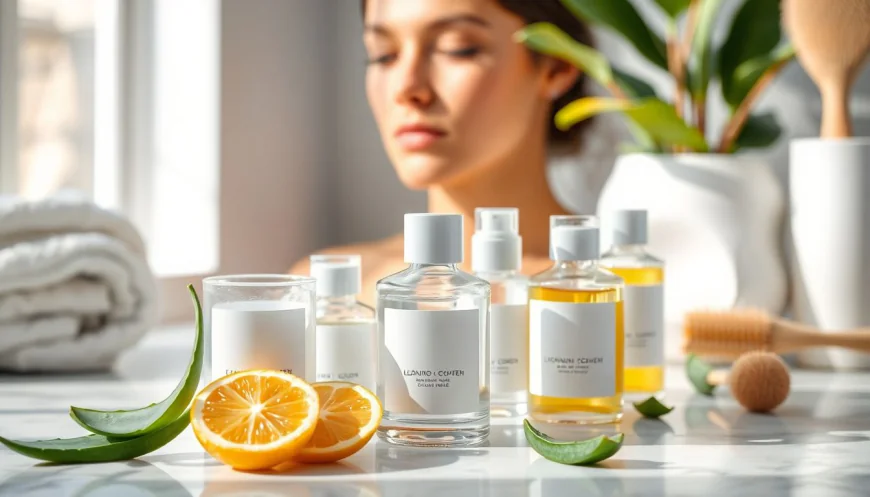Ultimate Guide to Skincare: Achieving Radiant, Healthy Skin
Taking care of your skin isn’t just about looks — it’s about your overall health and feeling confident. When your skin glows, so does your mood and self-esteem. With more and more people paying attention to skincare routines, the market now offers endless products and treatments. The global skincare industry grows rapidly, with billions spent every year. But with so many options out there, how do you choose what truly works? The secret lies in a personalized, science-backed routine that fits your skin type and goals.

Understanding Your Skin Type and Its Needs
Identifying Your Skin Type
Knowing your skin type is the first step toward healthier skin. Are you oily, dry, normal, sensitive, or a mix? You can find out by doing simple tests at home:
- Wash your face with a gentle cleanser.
- Leave your skin bare for about an hour.
- Observe how it feels and looks.
If your skin gets shiny quickly, you have oily skin. If it feels tight or flaky, it’s dry. Normal skin is balanced, with no major issues. Sensitive skin tends to react easily to new products or environmental changes. Recognizing your skin type helps you pick products that won’t cause breakouts or irritation.
Common Skin Concerns and Conditions
Many people deal with issues like acne, dark spots, or signs of aging. Hyperpigmentation causes uneven skin tone, while dehydration makes skin look dull. Sometimes, concerns are temporary, like after a stressful week. Other times, they’re chronic, needing professional advice. If a problem sticks around or worsens, visiting a dermatologist is a smart move.
The Role of Skin pH and Barrier Function
Your skin’s pH level affects how healthy it stays. Ideally, it should be slightly acidic, around 4.5 to 5.5. When pH is off, your skin can become sensitive or prone to breakout. The skin barrier — the outermost layer — keeps moisture in and irritants out. Damage to this barrier results in dryness, irritation, or premature aging. To maintain healthy skin, choose gentle cleansers, avoid harsh ingredients, and consider barrier-repair products like ceramides.
Building an Effective Skincare Routine
Cleansing: The Foundation of Healthy Skin
Cleansers are your first line of defense against dirt, oil, and pollution. Types include gel, cream, micellar water, and oil-based formulas. Use a cleanser suited for your skin type and stick to it twice daily. Over-cleansing or harsh scrubs can strip moisture, leading to irritation. Always gently pat your skin dry, not rub.
Hydration and Moisturization
Moisturizer keeps your skin smooth and protected. Even oily skin needs hydration. Look for ingredients like hyaluronic acid or glycerin that draw water into skin. For dry skin, richer creams with ceramides or oils work well. Use a moisturizer morning and night for best results, and don’t skip it even if your skin feels oily.
Sun Protection: The Anti-Aging Essential
Sunscreen is crucial every day, no matter the weather. Choose a broad-spectrum SPF 30 or higher. Apply generously 15 minutes before going outside and reapply every two hours if you're in the sun. Other protective steps include wearing hats, sunglasses, and seeking shade during peak hours. This prevents wrinkles, dark spots, and skin cancer.
Targeted Treatments and Serums
Depending on your skin goals, add active ingredients:
- Retinoids for anti-aging.
- Vitamin C for brightness.
- Salicylic acid for acne.
- Niacinamide for pore reduction.
Layer your products in order — start with lighter, water-based serums, followed by creams. Use these treatments at specific times; for example, retinoids at night.
Nighttime Skincare and Regeneration
While you sleep, your skin repairs itself. Using a night cream or serum enhances this process. Night treatments often contain stronger ingredients like retinol. Keep your routine simple, relaxing, and consistent. Always remove makeup and cleanse before bed.
Ingredient Insights and Safety
Key Skincare Ingredients and Their Benefits
Some ingredients are known for their proven benefits. Here are a few essentials:
- Vitamin C: Brightens skin and fights dark spots.
- Niacinamide: Reduces redness and improves skin elasticity.
- Salicylic acid: Clears pores and helps with acne.
- Retinol: Reduces wrinkles and boosts cell turnover.
Applying these in the right doses and combinations gives you real results.
Identifying and Avoiding Irritants
Watch out for common irritants like fragrances, sulfates, and parabens. Always read labels carefully. If your skin is sensitive, test new products on a small skin patch first. Choose fragrance-free options and consult products labeled for sensitive skin.
Natural vs. Clinical Skincare
Natural products appeal because they’re often perceived as safer. But not all-natural ingredients have science backing. Clinical-grade products contain potent ingredients backed by research. When dealing with serious concerns like severe acne or aging, professional-grade treatments can make a difference.
Lifestyle Factors Impacting Skin Health
Nutrition and Hydration
Eating well is key to glowing skin. Focus on fruits, vegetables, and foods rich in antioxidants like berries. Omega-3 fatty acids found in fish help keep skin flexible and moisturized. Drink plenty of water throughout the day; dehydration shows on your face fast.
Sleep and Stress Management
Lack of sleep and high stress levels accelerate aging signs. Prioritize 7-9 hours of quality sleep and find stress relief techniques that work for you — yoga, meditation, or just taking breaks. They all support healthier skin.
Environmental Influences
Pollution, UV rays, and harsh weather can damage your skin. Always apply antioxidant serums before sun exposure and use physical barriers like hats or scarves. After outdoor activities, wash your face to remove pollutants.
Conclusion
Achieving radiant, healthy skin is about more than just fancy products. It’s a mix of personalized routines, consistent habits, and using science-backed ingredients. Regular dermatologist visits can guide you further. Coupling skincare with a balanced lifestyle creates lasting results. Start simple — tailored routines help prevent overwhelm — then slowly add targeted treatments. Your best skin is within reach with patience and smart choices.



 VARSHITHA
VARSHITHA